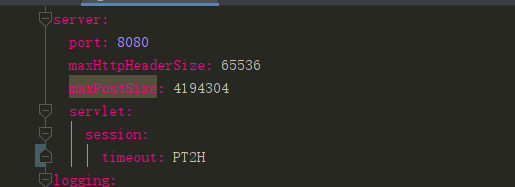springboot1.x设置session超时时间:
按优先级高到低说:
第一种:
spring boot 启动类里面:
package com.mycenter;
import org.mybatis.spring.annotation.MapperScan;
import org.springframework.boot.SpringApplication;
import org.springframework.boot.autoconfigure.SpringBootApplication;
import org.springframework.boot.context.embedded.EmbeddedServletContainerCustomizer;
import org.springframework.boot.web.servlet.ServletComponentScan;
import org.springframework.context.annotation.Bean;
@SpringBootApplication
@MapperScan(value = "com.mycenter.mapper")
@ServletComponentScan
public class MycenterApplication {
public static void main(String[] args) {
SpringApplication.run(MycenterApplication.class, args);
}
@Bean
public EmbeddedServletContainerCustomizer containerCustomizer(){
return container -> {
container.setSessionTimeout(7200);/*单位为S*/
};
}
}
第二种:

暂时用这两种。
springboot2.x设置session超时时间:
springboot2.x设置session时间使用的是java8新增的duration类,需要按照规范书写,例:

Duration转换字符串方式,默认为正,负以-开头,紧接着P,(字母不区分大小写)D :天 T:天和小时之间的分隔符 H :小时 M:分钟 S:秒 每个单位都必须是数字,且时分秒顺序不能乱。例:PT2H就是2个小时,7200秒。
/**
* Obtains a {@code Duration} from a text string such as {@code PnDTnHnMn.nS}.
* <p>
* This will parse a textual representation of a duration, including the
* string produced by {@code toString()}. The formats accepted are based
* on the ISO-8601 duration format {@code PnDTnHnMn.nS} with days
* considered to be exactly 24 hours.
* <p>
* The string starts with an optional sign, denoted by the ASCII negative
* or positive symbol. If negative, the whole period is negated.
* The ASCII letter "P" is next in upper or lower case.
* There are then four sections, each consisting of a number and a suffix.
* The sections have suffixes in ASCII of "D", "H", "M" and "S" for
* days, hours, minutes and seconds, accepted in upper or lower case.
* The suffixes must occur in order. The ASCII letter "T" must occur before
* the first occurrence, if any, of an hour, minute or second section.
* At least one of the four sections must be present, and if "T" is present
* there must be at least one section after the "T".
* The number part of each section must consist of one or more ASCII digits.
* The number may be prefixed by the ASCII negative or positive symbol.
* The number of days, hours and minutes must parse to an {@code long}.
* The number of seconds must parse to an {@code long} with optional fraction.
* The decimal point may be either a dot or a comma.
* The fractional part may have from zero to 9 digits.
* <p>
* The leading plus/minus sign, and negative values for other units are
* not part of the ISO-8601 standard.
* <p>
* Examples:
* <pre>
* "PT20.345S" -- parses as "20.345 seconds"
* "PT15M" -- parses as "15 minutes" (where a minute is 60 seconds)
* "PT10H" -- parses as "10 hours" (where an hour is 3600 seconds)
* "P2D" -- parses as "2 days" (where a day is 24 hours or 86400 seconds)
* "P2DT3H4M" -- parses as "2 days, 3 hours and 4 minutes"
* "P-6H3M" -- parses as "-6 hours and +3 minutes"
* "-P6H3M" -- parses as "-6 hours and -3 minutes"
* "-P-6H+3M" -- parses as "+6 hours and -3 minutes"
* </pre>
*
* @param text the text to parse, not null
* @return the parsed duration, not null
* @throws DateTimeParseException if the text cannot be parsed to a duration
*/
public static Duration parse(CharSequence text) {
Objects.requireNonNull(text, "text");
Matcher matcher = PATTERN.matcher(text);
if (matcher.matches()) {
// check for letter T but no time sections
if ("T".equals(matcher.group(3)) == false) {
boolean negate = "-".equals(matcher.group(1));
String dayMatch = matcher.group(2);
String hourMatch = matcher.group(4);
String minuteMatch = matcher.group(5);
String secondMatch = matcher.group(6);
String fractionMatch = matcher.group(7);
if (dayMatch != null || hourMatch != null || minuteMatch != null || secondMatch != null) {
long daysAsSecs = parseNumber(text, dayMatch, SECONDS_PER_DAY, "days");
long hoursAsSecs = parseNumber(text, hourMatch, SECONDS_PER_HOUR, "hours");
long minsAsSecs = parseNumber(text, minuteMatch, SECONDS_PER_MINUTE, "minutes");
long seconds = parseNumber(text, secondMatch, 1, "seconds");
int nanos = parseFraction(text, fractionMatch, seconds < 0 ? -1 : 1);
try {
return create(negate, daysAsSecs, hoursAsSecs, minsAsSecs, seconds, nanos);
} catch (ArithmeticException ex) {
throw (DateTimeParseException) new DateTimeParseException("Text cannot be parsed to a Duration: overflow", text, 0).initCause(ex);
}
}
}
}
throw new DateTimeParseException("Text cannot be parsed to a Duration", text, 0);
}
原文链接:https://www.cnblogs.com/unidentified/p/9518596.html























